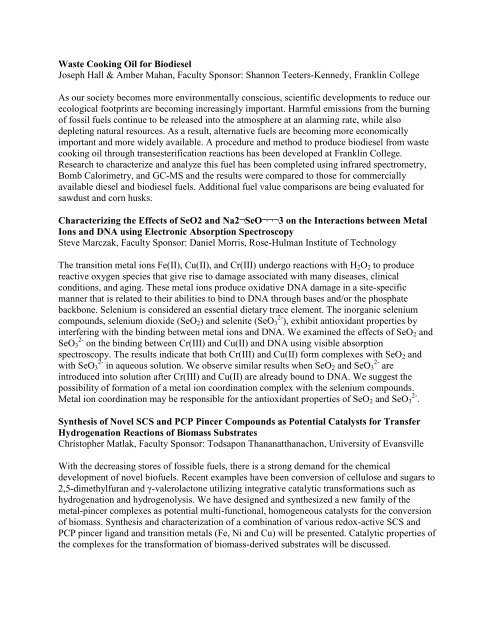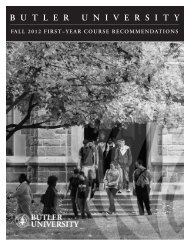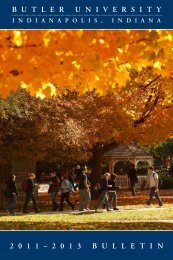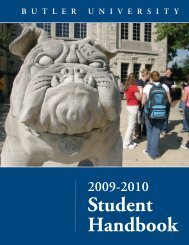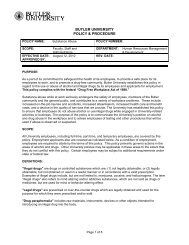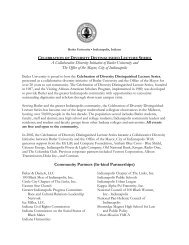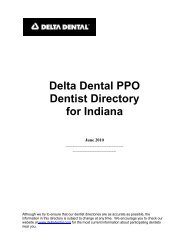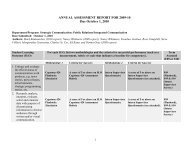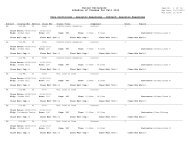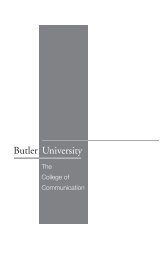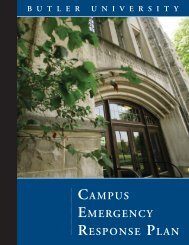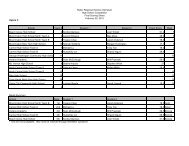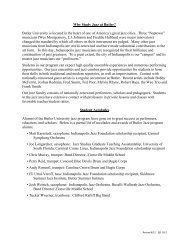Anthropology - Butler University
Anthropology - Butler University
Anthropology - Butler University
You also want an ePaper? Increase the reach of your titles
YUMPU automatically turns print PDFs into web optimized ePapers that Google loves.
Waste Cooking Oil for Biodiesel<br />
Joseph Hall & Amber Mahan, Faculty Sponsor: Shannon Teeters-Kennedy, Franklin College<br />
As our society becomes more environmentally conscious, scientific developments to reduce our<br />
ecological footprints are becoming increasingly important. Harmful emissions from the burning<br />
of fossil fuels continue to be released into the atmosphere at an alarming rate, while also<br />
depleting natural resources. As a result, alternative fuels are becoming more economically<br />
important and more widely available. A procedure and method to produce biodiesel from waste<br />
cooking oil through transesterification reactions has been developed at Franklin College.<br />
Research to characterize and analyze this fuel has been completed using infrared spectrometry,<br />
Bomb Calorimetry, and GC-MS and the results were compared to those for commercially<br />
available diesel and biodiesel fuels. Additional fuel value comparisons are being evaluated for<br />
sawdust and corn husks.<br />
Characterizing the Effects of SeO2 and Na2¬SeO¬¬¬3 on the Interactions between Metal<br />
Ions and DNA using Electronic Absorption Spectroscopy<br />
Steve Marczak, Faculty Sponsor: Daniel Morris, Rose-Hulman Institute of Technology<br />
The transition metal ions Fe(II), Cu(II), and Cr(III) undergo reactions with H 2 O 2 to produce<br />
reactive oxygen species that give rise to damage associated with many diseases, clinical<br />
conditions, and aging. These metal ions produce oxidative DNA damage in a site-specific<br />
manner that is related to their abilities to bind to DNA through bases and/or the phosphate<br />
backbone. Selenium is considered an essential dietary trace element. The inorganic selenium<br />
compounds, selenium dioxide (SeO 2 ) and selenite (SeO 3 2- ), exhibit antioxidant properties by<br />
interfering with the binding between metal ions and DNA. We examined the effects of SeO 2 and<br />
SeO 3 2- on the binding between Cr(III) and Cu(II) and DNA using visible absorption<br />
spectroscopy. The results indicate that both Cr(III) and Cu(II) form complexes with SeO 2 and<br />
with SeO 3 2- in aqueous solution. We observe similar results when SeO 2 and SeO 3 2- are<br />
introduced into solution after Cr(III) and Cu(II) are already bound to DNA. We suggest the<br />
possibility of formation of a metal ion coordination complex with the selenium compounds.<br />
Metal ion coordination may be responsible for the antioxidant properties of SeO 2 and SeO 3 2- .<br />
Synthesis of Novel SCS and PCP Pincer Compounds as Potential Catalysts for Transfer<br />
Hydrogenation Reactions of Biomass Substrates<br />
Christopher Matlak, Faculty Sponsor: Todsapon Thananatthanachon, <strong>University</strong> of Evansville<br />
With the decreasing stores of fossible fuels, there is a strong demand for the chemical<br />
development of novel biofuels. Recent examples have been conversion of cellulose and sugars to<br />
2,5-dimethylfuran and γ-valerolactone utilizing integrative catalytic transformations such as<br />
hydrogenation and hydrogenolysis. We have designed and synthesized a new family of the<br />
metal-pincer complexes as potential multi-functional, homogeneous catalysts for the conversion<br />
of biomass. Synthesis and characterization of a combination of various redox-active SCS and<br />
PCP pincer ligand and transition metals (Fe, Ni and Cu) will be presented. Catalytic properties of<br />
the complexes for the transformation of biomass-derived substrates will be discussed.


